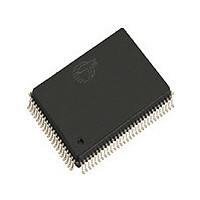CY7C1381C-100AI Cypress Semiconductor Corp, CY7C1381C-100AI Datasheet - Page 13

CY7C1381C-100AI
Manufacturer Part Number
CY7C1381C-100AI
Description
Manufacturer
Cypress Semiconductor Corp
Datasheet
1.CY7C1381C-100AI.pdf
(36 pages)
Specifications of CY7C1381C-100AI
Density
18Mb
Access Time (max)
8.5ns
Sync/async
Synchronous
Architecture
SDR
Clock Freq (max)
100MHz
Operating Supply Voltage (typ)
3.3V
Address Bus
19b
Package Type
TQFP
Operating Temp Range
-40C to 85C
Number Of Ports
1
Supply Current
175mA
Operating Supply Voltage (min)
3.135V
Operating Supply Voltage (max)
3.6V
Operating Temperature Classification
Industrial
Mounting
Surface Mount
Pin Count
100
Word Size
36b
Number Of Words
512K
Lead Free Status / Rohs Status
Not Compliant
Document #: 38-05238 Rev. *B
Functional Overview
All synchronous inputs pass through input registers controlled
by the rising edge of the clock. Maximum access delay from
the clock rise (t
The CY7C1381C/CY7C1383C supports secondary cache in
systems utilizing either a linear or interleaved burst sequence.
The interleaved burst order supports Pentium
processors. The linear burst sequence is suited for processors
that utilize a linear burst sequence. The burst order is
user-selectable, and is determined by sampling the MODE
input. Accesses can be initiated with either the Processor
Address Strobe (ADSP) or the Controller Address Strobe
(ADSC). Address advancement through the burst sequence is
controlled by the ADV input. A two-bit on-chip wraparound
burst counter captures the first address in a burst sequence
and automatically increments the address for the rest of the
burst access.
Byte write operations are qualified with the Byte Write Enable
(BWE) and Byte Write Select (BW
Enable (GW) overrides all byte write inputs and writes data to
all four bytes. All writes are simplified with on-chip
synchronous self-timed write circuitry.
Three synchronous Chip Selects (CE
asynchronous Output Enable (OE) provide for easy bank
selection and output tri-state control. ADSP is ignored if CE
is HIGH.
Single Read Accesses
A single read access is initiated when the following conditions
are satisfied at clock rise: (1) CE
asserted active, and (2) ADSP or ADSC is asserted LOW (if
the access is initiated by ADSC, the write inputs must be
deasserted during this first cycle). The address presented to
the address inputs is latched into the address register and the
burst counter/control logic and presented to the memory core.
If the OE input is asserted LOW, the requested data will be
available at the data outputs a maximum to t
rise. ADSP is ignored if CE
Single Write Accesses Initiated by ADSP
This access is initiated when the following conditions are
satisfied at clock rise: (1) CE
active, and (2) ADSP is asserted LOW. The addresses
presented are loaded into the address register and the burst
inputs ( GW, BWE, and BW
cycle. If the write inputs are asserted active ( see Write Cycle
Descriptions table for appropriate states that indicate a write)
on the next clock rise,the appropriate data will be latched and
written into the device.Byte writes are allowed. All I/Os are
tri-stated during a byte write.Since this is a common I/O
device, the asynchronous OE input signal must be deasserted
and the I/Os must be tri-stated prior to the presentation of data
C0
) is 6.5 ns (133-MHz device).
1
is HIGH.
X
)are ignored during this first clock
1
, CE
1
X
, CE
2
) inputs. A Global Write
, CE
1
, CE
2
, and CE
3
[2]
2
, CE
are all asserted
CDV
®
3
[2]
after clock
3
and i486
[2]
) and an
are all
1
to DQs. As a safety precaution, the data lines are tri-stated
once a write cycle is detected, regardless of the state of OE.
Single Write Accesses Initiated by ADSC
This write access is initiated when the following conditions are
satisfied at clock rise: (1) CE
active, (2) ADSC is asserted LOW, (3) ADSP is deasserted
HIGH, and (4) the write input signals (GW, BWE, and BW
indicate a write access. ADSC is ignored if ADSP is active LOW.
The addresses presented are loaded into the address register
and the burst counter/control logic and delivered to the
memory core. The information presented to DQ
written into the specified address location. Byte writes are
allowed. All I/Os are tri-stated when a write is detected, even
a byte write. Since this is a common I/O device, the
asynchronous OE input signal must be deasserted and the
I/Os must be tri-stated prior to the presentation of data to DQs.
As a safety precaution, the data lines are tri-stated once a write
cycle is detected, regardless of the state of OE.
Burst Sequences
The CY7C1381C/CY7C1383C provides an on-chip two-bit
wraparound burst counter inside the SRAM. The burst counter
is fed by A
burst order. The burst order is determined by the state of the
MODE input. A LOW on MODE will select a linear burst
sequence. A HIGH on MODE will select an interleaved burst
order. Leaving MODE unconnected will cause the device to
default to a interleaved burst sequence.
Interleaved Burst Address Table
(MODE = Floating or V
Linear Burst Address Table
(MODE = GND)
Address
Address
A1: A0
A1: A0
First
First
00
01
10
00
01
10
11
11
[1:0]
, and can follow either a linear or interleaved
Address
Address
Second
Second
A1: A0
A1: A0
01
00
11
10
01
10
11
00
1
, CE
DD
)
2
Address
Address
, and CE
A1: A0
A1: A0
Third
Third
10
00
01
10
00
01
11
11
CY7C1381C
CY7C1383C
3
[2]
are all asserted
Page 13 of 36
Address
Address
[A:D]
Fourth
A1: A0
Fourth
A1: A0
11
10
01
00
11
00
01
10
will be
X
)
[+] Feedback











